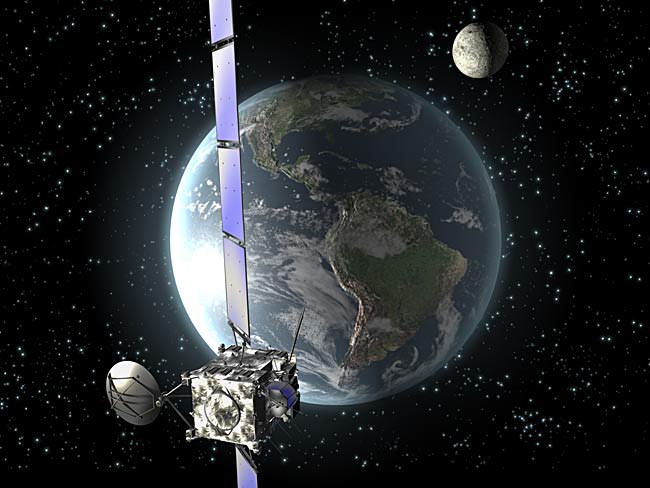One of our favorite astronauts, Chris Hadfield from Canada, was recently part of the NEEMO-14 crew — NASA’s Extreme Environment Mission Operations — who spent two weeks in an underwater habitat simulating a long-duration space mission. The crew put together this great video showing what it would be like to walk and jump on the Moon, Mars and an asteroid. The “Aquanauts” and support divers are weighted down to simulate the different gravity. There’s also a jet pack demonstration, which the crew decided is needed for any future mission to an asteroid!
Mentos X-1 Blasts Off
For the rocket nerd in all of us…
Is Ball Lightning Just a Shared Hallucination?
[/caption]
For hundreds of years, people have reported seeing ball lighning, a weird phenomenon that resembles glowing, hovering spheres of electricity sometimes witnessed during lightning storms. But scientists have never been able to explain what causes it or even what it really is. Even though some surveys say that 1 in 150 people have seen ball lightening, photographic evidence is basically nonexistent. There are dozens of theories of how ball lightning could form, including the burning of hot silicon particles produced when a lightning strike vaporizes the ground. When people who claim they have seen ball lightining try to explain what they saw, often they are told, “You must be seeing things!”
Perhaps they are.
A pair of physicists from Austria say that the magnetic fields associated with certain types of lightning strikes are powerful enough to create hallucinations of hovering balls of light in nearby observers, and that these visions would be interpreted as ball lightning.
Alexander Kendl and Joseph Peer from the University of Innsbruck analyzed electromagnetic pulses of repetitive lightning discharges and compared them to the magnetic fields used in clinical transcranial magnetic stimulation (TMS), which is a technique used by neuroscientists to explore the workings of the brain; it is also used for psychiatric treatments. Patients are subjected to a rapidly changing magnetic field that is powerful enough to induce currents in neurons in the brain. Patients will sometimes see hallucinations of luminous shapes in their visual field.
Rare but natural long (1-2 seconds) and repetitive lightning strikes produce electromagnetic pulses similar to what happens during TMS. The researchers calculated the time-varying electromagnetic fields of various types of lightning strikes for observers at various distances from the strike, from 20-100 meters away.
Their results suggest the variable magnetic fields produced by lightning are very similar to TMS, in both magnitude and frequency. Those people undergoing TMS have hallucinations, and see balls of light known as cranial phosphenes.
Kendl and Peer postulated that ball lightning could be hallucinations arising from lightning electromagnetic pulses affecting the brains of close observers.
“As a conservative estimate, roughly 1% of (otherwise unharmed) close lightning experiencers are likely to perceive transcranially induced above-threshold cortical stimuli,” said Peer and Kendl in their paper. They add that these observers need not be outside but could be otherwise safely inside buildings or even sitting in aircraft.
The calculations showed that only lightning strikes consisting of multiple return strokes at the same point over a period of seconds could produce a magnetic field long enough to cause cortical phosphenes. This type would account for around 1-5% of lightning strikes, but very few of these would be seen by an observer 20 to 100 meters away, and of those the researchers estimate seeing the light for seconds would occur only in about one percent of unharmed observers. The observer does not need to be outside, but could be inside an aircraft or building. Kendl and Peer also said an observer would be most likely to classify the experience as ball lightning because of preconceptions.
One of the earliest descriptions of ball lighting comes from way back in 1638 at a church in Widecombe-in-the-Moor, Devon, in England. Four people died and approximately 60 were injured when, during a severe storm, an 8-foot (2.4 m) ball of fire was described as striking and entering the church, nearly destroying it. Large stones from the church walls were hurled into the ground and through large wooden beams. The ball of fire allegedly smashed the pews and many windows, and filled the church with a foul sulfurous odor and dark, thick smoke.
That doesn’t sound like a hallucination, but many question whether the reports are accurate or not. Read some more reports of ball lighting at Wikipedia.
Have you seen ball lightning, or know someone who has?
Sources: PhysOrg, Technology Review Blog
Final Shuttle Flight Will Be Delayed at Least Until November for AMS Switchout

[/caption]
A switch-out of the magnet for a much anticipated particle physics experiment on the International Space Station will force NASA to delay the final flight of the space shuttle until at least November, and change which orbiter and crew will fly the final space shuttle mission. The $2 billion Alpha Magnetic Spectrometer was scheduled to head to the ISS in July of this year, but recent thermal vacuum tests showed the superconducting magnet that was originally planned to power the experiment would have only worked 2-3 years. An ordinary magnet, which doesn’t need to be super-cooled will last for a decade or more – and given the ISS has been given a longer life, it seems to be the best option. “I don’t think it’s correct to go there for three years where there is a chance to do physics for 18 years,” said Dr. Samuel Ting, AMS Principal Investor, in an article in the New York Times.
NASA officials said today they still are evaluating the exact day in November, as they must schedule the mission to fit around other resupply and crew flights to the ISS, with the Russian Progress and Soyuz vehicles.
The AMS is designed to search for various types of unusual matter by measuring cosmic rays, and will help researchers study the formation of the universe and search for evidence of dark matter and antimatter.
Changing the magnet means the AMS won’t arrive at Kennedy Space Center before August and shuttle workers need time to get the payload ready to fly inside the shuttle’s cargo bay.

The upcoming flight of the shuttle Atlantis (STS-132) remains on schedule for launch no earlier than May 14. But Endeavour was scheduled for the AMS flight in July, which will now move to no earlier than November. Discovery’s STS-133 flight (bringing up the Leonardo MPLM as a permanent storage module) stays on the schedule for September 16. So while the schedule changes, numerical order is restored!
Another possible change to the shuttle schedule would be if the decision to fly what is called STS-335, the Launch On Need mission, a shuttle ready to go as a rescue ship for the last scheduled mission. Many shuttle supporters say since Atlantis would be ready to fly that it should fly. No decision has yet been made, however.
Even if the final flight or flights get delayed into 2011, funding is not a problem, as Congress anticipated possible delays and provided funds for shuttle operations into early next year.
Liquid helium would have been used cool the superconducting magnet’s temperature to near absolute zero. But tests showed the helium would dissipate withing 2-3 years, leaving the seven-ton experiment useless. The ISS has been extended to at least 2020, and possibly as long as 2028.
Sources: New York Times, Orlando Sentinel
Incredible Images of Iceland Volcano from Just a Few Kilometers Away
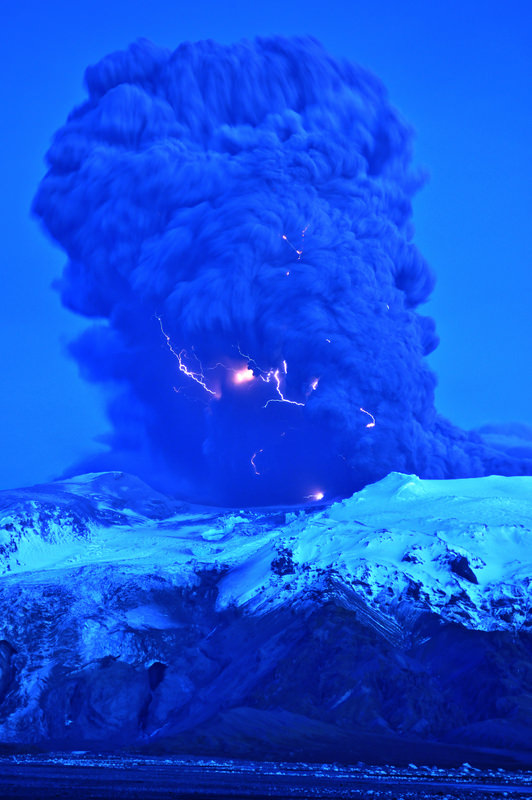
[/caption]
Astronomer Snaevarr Gudmundsson from Iceland was able to travel to within just a few kilometers from the Eyjafjallajokull volcano, and shared his incredible close-up images with Universe Today. “I stayed near the volcano from about 16:00 hours to 22:00 hours on Saturday and watched its impressive eruption,” Gudmundsson said in an email to me. “Amazing event, awesome explosions of 1200 °C hot magma reaching ice and water. I shot more than 550 images during these hours of continuous enjoyment. Sounds ridiculous but its ever changing appearance was never boring.”
The massive plume put on an impressive display – from lightning forming within the plume to an incredible amount of spewing ash. On one of following pictures you can see helicopter for size comparison of the plume
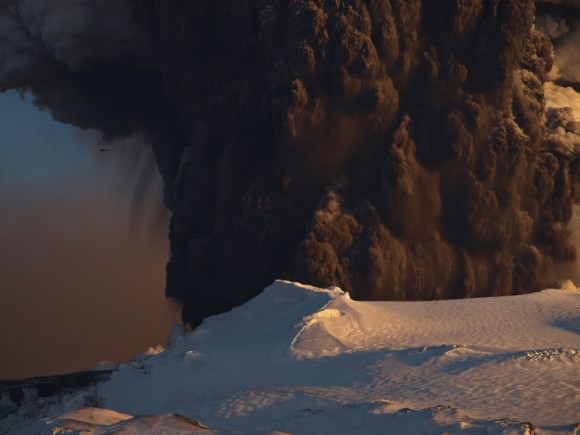
Gudmundsson said he and other photographers were a safe distance from the eruption, but were a few kilometers away. “Nearby was a small river and its prominent sound prevented us from hearing much in the eruption itself except a loud roar from thunders from time to time,” he said. “During daylight we even glimpsed some lightning but at dusk (the photo is taken at about 22:00 in the evening) they were easily spotted especially during active periods of explosions.”
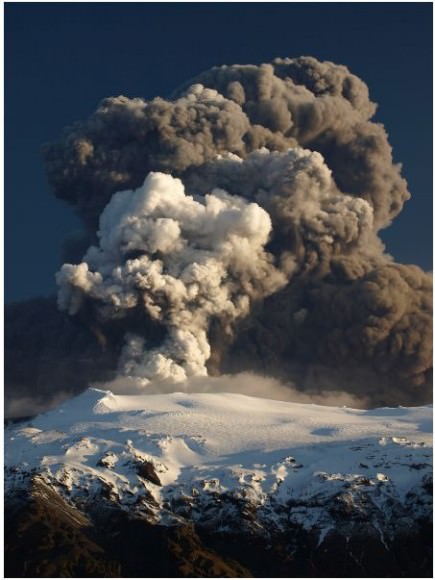
I asked if there was any smell associated with the Iceland volcano and Gudmundsson said there was a bit of sulphuric smell in the air even though they were in a location where the wind was blowing towards the volcano. “The ash went to the other side of the volcano, as you can suggest, making life miserable for farmers and households below, but the rest of it climbed to higher altitude and from there to Europe.”
“From the foot of the volcano to the prominent top, seen in front of the tephra cloud (seen on some of the photos) the overall height is about 1300 -1400 m,” Gudmundsson said. “When the eruption began a huge flood went down beneath the obvious glacier to the left from the crater. And if you look closely on the photo showing the foot hills under the mountain a lot of icebergs can be seen on the flood plain. Under that same glacier was a rather deep lagoon (can’t been seen but sat between the two high moraines on either side of it, in front of the glacier) but sediment from the eruption filled it up in only two days at most! That is unbelievable. I have climbed this glacier many times but to approach it one usually must traverse the moraine, around the lagoon to reach the ice. But suddenly it is gone.”

Gudmundsson said the flood paths can be seen below the glacier as a narrow gorges carved into rather soft volcanic sediment.
Some of the latest reports from Iceland say that in some areas the volcanic fallout has been significant, clogging car engines, turning grass grey and reducing visibility to just a few meters.
The police say driving conditions can be very difficult in these places, but the area affected is remote with only a few hundred people, most of them living in isolated homes and many of them farmers. They have been advised to stay inside with the windows and doors shut and if they do venture out to wear goggles and a mask.
The staff of Landhelgisgæslan (Icelandic Coastal Patrol) captured this radar image of the craters in Eyjafjallajökull on Friday. There are three main openings and each one is 200-500m in diameter.
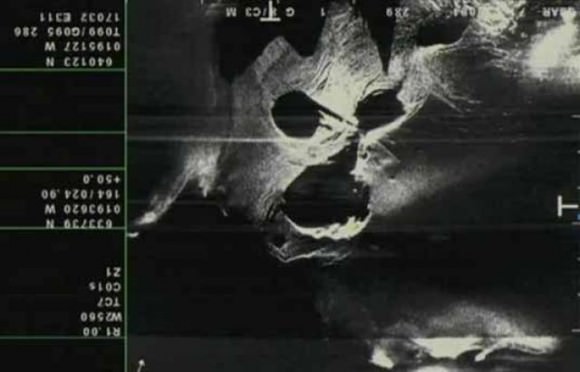
Our very special thanks to Snaevarr Gudmundsson for sharing his images and experiences of seeing the volcano “up close and personal.” Also thanks to Col Maybury of radio station 2NUR in Newcastle, Australia for connecting me with Snaevarr (yes my connection to Iceland came through Australia!) and also thanks to erlinger on Twitter for help with Icelandic translations of news reports.
Here are some more Iceland pictures.
Solar-Powered Airplane Makes Maiden Voyage
A solar powered airplane that one day will attempt an around the world non-stop flight took its maiden voyage yesterday in Switzerland. Solar Impulse flew for 87 minutes and climbed to 1,200 meters. “This first flight was for me a very intense moment!” exclaimed test pilot Markus Scherdel immediately after the flight. “The HB-SIA behaved just as the flight simulator told us! Despite its immense size and feather weight, the aircraft’s controllability matches our expectations!”
[/caption]
“We reached all objectives, especially the safe landing, which was our main purpose,” said Claude Nicollier, a former astronaut who is one of the leaders of the project.
The plane has a 61 meter wingspan, and the wings are covered with 12,000 state-of-the-art photovoltaic solar cells that power the plane. Using so-called intelligent light materials and new energy storage, the plane will be able to fly both night and day, completely on solar power. Solar impulse weights 1,600 kg and can fly at speeds up to 70 kmh at a maximum altitude of 8,500 m (27 900 ft)
“We .still have a long way to go until the night flights and an even longer way before flying round the world, but today, thanks to the extraordinary work of an entire team, an essential step towards achieving our vision has been taken,” said Solar Impulse Chairman and initiator Bertrand Piccard. “Our future depends on our ability to convert rapidly to the use of renewable energies. Solar Impulse is intended to demonstrate what can be done already today by using these energies and applying new technologies that can save natural resources.”
For more information on Solar Impulse.
Astronomy Without A Telescope – Is An Anomalous Anomaly A Normality?
The lack of any flyby anomaly effect when the Rosetta spacecraft passed Earth in November 2009 is what, an anomaly? No. Anomalies arise when there is a mismatch between a predicted and an observed value. When it happens our first thought shouldn’t be that OMG there’s something wrong with physics! We should probably start by reviewing whether we really got the math right.
The flyby anomaly story starts with the Galileo spacecraft‘s flyby of Earth in December 1990 – where it was measured to have gained a speed increase (at least, an increase over the predicted value) of 2.5 millimeters per second at perigee. In its second pass in December 1992, the predicted value was the same as the observed value, although it has been suggested that atmospheric drag effects confound any analysis of this particular flyby.
The next, and biggest anomaly so far detected, was the NEAR spacecraft‘s flyby in 1998 (a whopping 7.2 millimeters per second at perigee increase over the predicted value). After that you have Rosetta showing an anomaly on its first flyby in 2005. Then a quantitative formula which aimed to model the various flybys to date was developed by Anderson et al in 2007 – predicting a small but detectable speed increase would be found in Rosetta’s second fly-by of 13 November 2007. However (or should I say anomalously), no such increase was detected in this, or in Rosetta’s third (2009), pass.
So, on balance, our spacecraft (and often the same spacecraft) are more likely to behave as predicted than to behave anomalously. This reduces (though not negates) the likelihood of the anomaly being anything of substance. One might sagely state that the intermittent absence of an anomaly is not in itself anomalous.
More recently, Mbelek in 2009 has proposed that the anomalous flyby data (including Anderson et al’s formula) can be explained by a more rigorous application of special relativity principles, concluding that ‘spacecraft flybys of heavenly bodies may be viewed as a new test of SR which has proven to be successful near the Earth’. If such recalculated predicted values match observed values in future flybys, that would seem to be that.

Then there’s the Pioneer anomaly. This has no obvious connection with the flyby anomaly, apart from a common use of the word anomaly, which gives us another epistemological maxim – two unrelated anomalies do not one bigger anomaly make.
Between around 20 and 70 AU out from Earth, Pioneer 10 and 11 both showed tiny but unexpected decelerations of around 0.8 nanometers per second2 – although again we are just talking about an observed value that differed from a predicted value.
Some key variables not considered in calculating the original predicted value are radiation pressure from sunlight-heated surfaces, as well as internal radiation generated from the spacecrafts’ own (RTG) power source. A Planetary Society update of an ongoing review of the Pioneer data indicated that revised predicted values now show less discrepancy from the observed values. Again, this doesn’t yet negate the anomaly – but given the trend for more scrutiny equals less discrepancy, it’s fair to say that this anomaly is also becoming less substantial.
Don’t get me wrong, this is all very useful science, teaching us more about how our spacecraft operate out there in the field. I am just suggesting that when faced with a data anomaly perhaps our first reaction should be Doh! rather than OMG!
Skydiver Hopes to Break the Speed of Sound in Freefall
[/caption]
The speed of sound — historically called the ‘sound barrier’ – has been broken by rockets, various jet-powered aircraft and rocket-boosted land vehicles. Felix Baumgartner wants to break the sound barrier with his body, in freefall from the edge of space. He will travel inside a capsule with a stratospheric balloon to 36,500 meters (120,000 feet) step out and attempt a freefall jump targeted to reach – for the first time in history – supersonic speeds.
“After years of training with my team of dedicated Red Bull Stratos experts, I’ll be going on a journey that no one has ever done,” Baumgartner told Universe Today in an email message. “If I succeed, I will be the first person to break the sound barrier, alone. That will be a record for all eternity. As such, a piece of me will become immortal. That excites me.”

Back in 1960, a US Air Force captain named Joe Kittinger made aerospace history by making a jump from 31,000 meters (102,800 feet). His jump contributed valuable data that provided ground work for spacesuit technology and knowledge about human physiology for the US space program. There have been several attempts to surpass Kittinger’s record, but none have succeeded, and people have given their lives for the quest.
Sometime during 2010, Baumgartner will make an attempt in his “Red Bull Stratos” mission — named after the energy drink company that co-created the program with the Austrian skydiver. Red Bull Stratos team members say the mission will explore the limits of the human body in one of the most hostile environments known to humankind, in the attempt to deliver valuable lessons in human endurance and high-altitude technology.
“This is the biggest goal I can dream of,” Baumgartner said. “If we can prove that you can break the speed of sound and stay alive I think that is a benefit for future space exploration.”
If Baumgartner is successful, the Red Bull Stratos mission will break four world records: the altitude record for freefall, the distance record for longest freefall, the speed record for fastest freefall by breaking the speed of sound with the human body, and the altitude record for the highest manned balloon flight.

How fast will Baumgarter need to go to beat the speed of sound? Sound travels at different speeds through the atmosphere (as well as through different mediums), depending on atmospheric density and temperature. For example, at sea level, in average conditions of about 15 degrees C (59 degrees F), sound travels at around 1,223 kph (760 mph). But at higher altitudes, where the air is colder, sound travels more slowly.
Researchers with the Red Bull Stratos mission anticipate Baumgartner could break the sound barrier at about 30,480 meters (100,000 feet) above sea level, in temperatures of -23 to -40 C (-10 to -40 F) where sound travels at about 1,110 kph (690 mph) or roughly 304 meters per second (1,000 feet per second).
So, he’ll have to go faster than those speeds – or Mach 1 — to be supersonic.
While there is no literal “barrier,”the transition to supersonic speeds can cause problems for aircraft as transonic air movement creates disruptive shock waves and turbulence. Data obtained from Chuck Yeager’s first supersonic flight in 1947 allowed for changes in design of supersonic aircraft to avoid problems. Still, some aircraft still experience problems, and going supersonic has been attributed to some air disasters.
And the human body isn’t designed for supersonic speeds.
“Our biggest concern is that we don’t know how a human unencumbered by aircraft is going to transition through this,” said the project’s Medical Director Dr. Jonathan Clark, a flight surgeon for six space shuttle missions (and husband of astronaut Laurel Clark who died in the Columbia disaster in 2003), who has researched numerous aerospace disasters. “But it’s also exactly what we’re hoping to learn, for the benefit of future space flights.”
Documents provided by the Red Bull Stratos mission say that the data obtained from the mission will be shared with the scientific community, and Clark notes that he expects long-awaited medical protocols to be established as a result.
At the low temperatures and tenuous atmospheric conditions that Baumgartner will experience, he could suffer from hypothermia, the bends –if he gains altitude too fast during ascent –, or he could experience ebullism – the infamous condition where gas bubbles can form in the blood, and the blood basically “boils.”
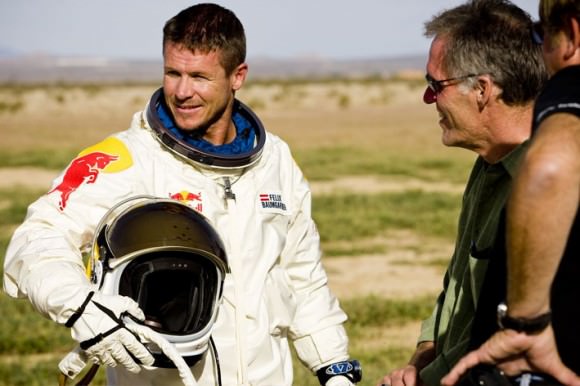
That’s why his spacesuit is so important.
“I have absolute confidence the suit is going to work,” said Daniel McCarter, Program Manager for the David Clark Company, the same company that made Kittinger’s suit back in 1960, as well as full pressure suits for NASA astronauts and military pilots flying in aircraft that can reach the edge of the atmosphere. “Every time someone jumps a suit system like this there is something to learn. We learn knowledge for future systems.”
Art Thompson, the mission’s Technical Project Director, added, “We are ultimately risking life. Felix realizes that his life is on the line. Our job is to do everything we can from an engineering and technical point of view to keep him safe.”
The suit Baumgartner will use is custom-made for him, so there should be no pressure points caused by the suit that would make him uncomfortable, but any pressure suit restricts mobility and dexterity. He will have to avoid movements that could cause him to go into an uncontrollable spin.
Baumgartner is not new to jumping. He owns several world records for B.A.S.E. jumping and is well known for skydiving across the English Channel in 2003. He is also a parachutist, stunt coordinator and a commercial helicopter pilot.
“I think I’ve always been one of those guys who wanted to be in the places where no one has been before. It’s inside your body or brain,” Baumgartner said in a video on the Red Bull Stratos website. “When I was a kid, I liked to climb up trees –I always wanted to be on top of something.”
This will definitely be an attempt to go where no one has gone before.
For more information on the mission, visit the Red Bull Stratos website, or Felix Baumgartner’s website.
LHC Sets Record for Particle Collisions, Marks “New Territory” in Physics

Physicists at the CERN research center collided sub-atomic particles in the Large Hadron Collider on Tuesday at the highest speeds ever achieved. “It’s a great day to be a particle physicist,” said CERN Director General Rolf Heuer. “A lot of people have waited a long time for this moment, but their patience and dedication is starting to pay dividends.” Already, the instruments in the LHC have recorded thousands of events, and at this writing, the LHC has had more than an hour of stable and colliding beams.
This is an attempt to create mini-versions of the Big Bang that led to the birth of the universe 13.7 billion years ago, providing new insights into the nature and evolution of matter in the early Universe.
Continue reading “LHC Sets Record for Particle Collisions, Marks “New Territory” in Physics”
Watch History Live from the Large Hadron Collider

[/caption]
CERN announced that on March 30 they will attempt to circulate beams in the Large Hadron Collider at 3.5 TeV, the highest energy yet achieved in a particle accelerator. A live webcast will be shown of the event, and will include live footage from the control rooms for the LHC accelerator and all four LHC experiment, as well as a press conference after the first collisions are announced.
“With two beams at 3.5 TeV, we’re on the verge of launching the LHC physics program,” said CERN’s Director for Accelerators and Technology, Steve Myers. “But we’ve still got a lot of work to do before collisions. Just lining the beams up is a challenge in itself: it’s a bit like firing needles across the Atlantic and getting them to collide half way.”
The webcast will be available at a link to be announced, but the tentative schedule of events (subject to change) and more information can be found at this link.
Webcasts will also be available from the control rooms of the four LHC experiments: ALICE, ATLAS, CMS and LHCb. The webcasts will be primarily in English.
Between now and 30 March, the LHC team will be working with 3.5 TeV beams to commission the beam control systems and the systems that protect the particle detectors from stray particles. All these systems must be fully commissioned before collisions can begin.
“The LHC is not a turnkey machine,” said CERN Director General Rolf Heuer.“The machine is working well, but we’re still very much in a commissioning phase and we have to recognize that the first attempt to collide is precisely that. It may take hours or even days to get collisions.”
The last time CERN switched on a major new research machine, the Large Electron Positron collider, LEP, in 1989 it took three days from the first attempt to collide to the first recorded collisions.
The current Large Hadron Collider run began on 20 November 2009, with the first circulating beam at 0.45 TeV. Milestones were quick to follow, with twin circulating beams established by 23 November and a world record beam energy of 1.18 TeV being set on 30 November. By the time the LHC switched off for 2009 on 16 December, another record had been set with collisions recorded at 2.36 TeV and significant quantities of data recorded. Over the 2009 part of the run, each of the LHC’s four major experiments, ALICE, ATLAS, CMS and LHCb recorded over a million particle collisions, which were distributed smoothly for analysis around the world on the LHC computing grid. The first physics papers were soon to follow. After a short technical stop, beams were again circulating on 28 February 2010, and the first acceleration to 3.5 TeV was on 19 March.
Once 7 TeV collisions have been established, the plan is to run continuously for a period of 18-24 months, with a short technical stop at the end of 2010. This will bring enough data across all the potential discovery areas to firmly establish the LHC as the world’s foremost facility for high-energy particle physics.
Source: CERN



